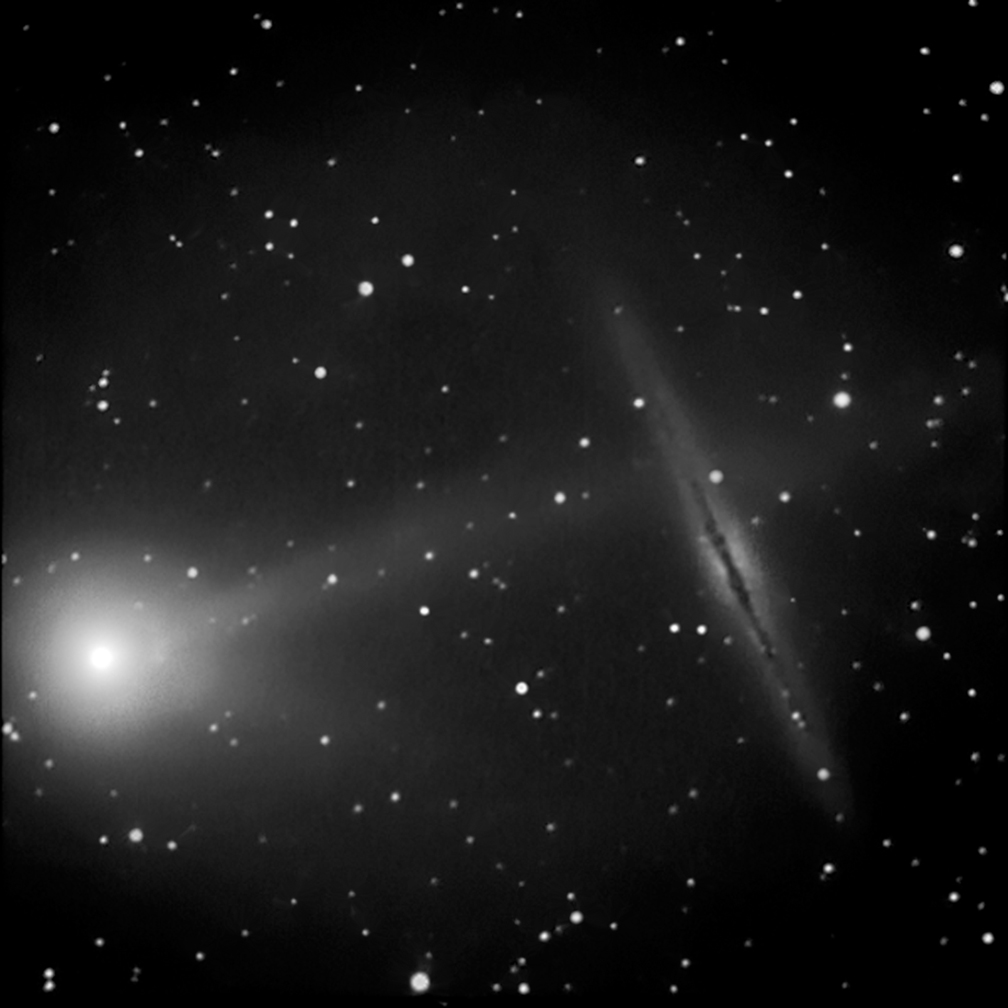
(click on photo to enlarge)
Posted on 06/11/2010 6:41:53 AM PDT by ETL
One wonders... Did the inhabitants of galaxy NGC 891 duck when Comet McNaught flew past the edge-on spiral on the morning of June 8th? Mike O'Connor and Tristan Dilapo took this picture of the cosmic close encounter from Colden, New York:
"The comet was only 10 degrees above the horizon," says O'Connor. "Nevertheless, we got a good picture using a 12-inch telescope and an SBIG ST9-E camera."
And, no, the denizens of that distant galaxy did not flinch, flee, duck or take notice in any way. NGC 891 is 30 million light years away, far removed from the willowy tail of Comet McNaught.
We Earthlings are having the true close encounter. Comet McNaught (C/2009 R1) is gliding through the inner solar system, due to approach our planet only 100 million miles away on June 15th and 16th. The approaching comet looks great in small telescopes, and may yet become a naked-eye object before the end of the month. Because this is Comet McNaught's first visit, predictions of future brightness are necessarily uncertain; amateur astronomers should be alert for the unexpected.
Get the full story and a finder chart from Sky & Telescope. See also: ephemeris, 3D orbit.
more images: from Kerry-Ann Lecky Hepburn of Grimsby, Ontario; from Gregg Ruppel of Ellisville, MO; from Michael Jäger of Turmkogel, Austria; from Scott Tucker of Tucson, Arizona; from Jeff Greenwald of Laramie, Wyoming; from Feys Filip at the Public observatory "Sasteria" in Crete; from Gary of Fort Davis, TX; from Baqir of Quetta, Pakistan
Comet in the June Dawn
Bring binoculars to catch Comet C/2009 R1 (McNaught) low in the northeast.
May 19, 2010
On the morning of June 5th the comet skims just north of the large, loose open cluster NGC 752. On June 6th and 7th it’s within about 2° of the 2nd-magnitude double star Gamma Andromedae. The Moon is much thinner then, but also closer to the comet.
Mid-June is when Comet McNaught should be most interesting, offering the best compromise between its increasing brightness and its decreasing altitude at the start of dawn. Moreover, the sky will be free of moonlight.
The helpful conjunctions continue as the comet passes about 1° north of the open cluster M34 in Perseus on the morning of June 10th, and 3° south of 1.8-magnitude Mirfak (Alpha Persei) on the 13th. It’s still about 15° high in the northeast as the sky starts to grow light on June 15th, but it appears roughly 1° lower every day after that. The comet passes zero-magnitude Capella on the 21st, and it’s very low by the 24th, when it passes 2nd-magnitude Beta Aurigae. By now Comet McNaught may be as bright as 4th magnitude, but moonlight is returning.
The comet will be lost to view by June’s end — just before it reaches perihelion on July 2nd, 0.405 astronomical unit from the Sun. It remains far from Earth throughout this apparition, never venturing closer than 1.135 a.u. (in mid-June)[1 a.u. = ~92.5 million miles -etl]. After perihelion it will fade rapidly as it heads to the far-southern sky.
The comet is approaching on a hyperbolic orbit, which means that it’s making its first trip in from the Oort Cloud. So its brightness is even less predictable than usual. Will it flare unexpectedly or perhaps fizzle out?
Print out our map, plan where and when to look (find when astronomical twilight begins at your location using our almanac; don't forget to check the Daylight Saving Time box if necessary), and see for yourself.
http://www.skyandtelescope.com/observing/highlights/94277259.html
Of course the comet, if you can find it with binoculars or the unaided eye, will NOT be nearly as bright as it is in the photo above. It will look more like a faint smudge.
So the galaxy in the background is Andromeda?
No. The Andromeda galaxy is only about 2.5 light-years away. It lies within our own local group of galaxies. This one is part of a more distant group which just happens to lie in the constellation of Andromeda .
"NGC 891 is an edge on unbarred spiral galaxy about 30 million light-years away in the constellation Andromeda. It was discovered by William Herschel on October 6 1784. The galaxy is a member of the NGC 1023 group of galaxies in the Local Supercluster. It has an H II nucleus.[3]"
Nope. This is Andromeda:

Thanks to you and ETL.
I wish we could get a comet as beautiful and visible as Hyakutake and Hale-Bopp were. Those were awesome to view in the night sky. Didn’t even need binoculars, one only had to look up!
I don’t remember Hyakutake, but Hale-Bopp was incredible! I think it was visible with the unaided eye even in twilight.
Yeah, but every time we get a Hale-Bopp, we get a bunch of weirdos that want to cut off their balls, thinking that’s the only way to catch a ride.
Nice pic.

Amazing. Thank you for the post.
One wonders... Do the inhabitants of the media understand that space is three dimensional, and even though objects appear close in the sky, they may be millions of light-years apart?
The site I linked to (spaceweather.com) is a NASA one. They weren't being serious about the comet (really) being close to the galaxy.
Disclaimer: Opinions posted on Free Republic are those of the individual posters and do not necessarily represent the opinion of Free Republic or its management. All materials posted herein are protected by copyright law and the exemption for fair use of copyrighted works.